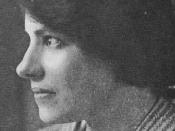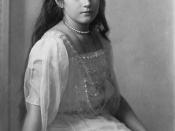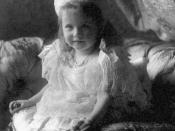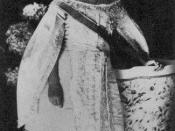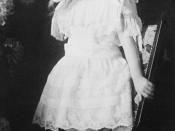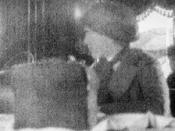Pretending to be something or someone we are not has been around since... forever. Many of us, if not all of us, have at some point misrepresented ourselves in one way or another to a certain extent, weather it saying that you'll fly out to meet someone in your private helicopter or saying that your favorite band of all time is Pulp, but how far we have taken these lies are limited. It is seldom we live these lies until we die, but certain people in the past have taken their claims to their deathbed. People pretend to be something or someone else for numerous reasons, but the most common one is attention. The 'trend to pretend' is all around us. People have always pretended to impress other people, wanted others to think that you are special and deserving of time, or simply to escape the harsh reality that we today are forced to live with.
There have been many famous cases of people pretending to be someone else, taking after their personality, physical features, and lifestyle, just for their 15 min of fame. But have any of these people actually been who they claim they are? In the case of the highly controversial Grand Duchess Anastasia of Russia, there have been many impersonators through time, but only two stand out as being exceptionally well, Anna Anderson and Eugenia Smith. Anna Anderson took her claim to the grave while Eugenia Smith withdrew her statement a few years later, and wrote a novel about her experience as 'Anastasia'. But what about Anna Anderson, there is evidence both for and against, some being more compelling and other being pretensions and unconvincing. Was Anna Anderson, whom shortly passed away, really Anastasia? In the following I shall analyze the evidence both fore and against as well as the sources on which they were 'confirmed'.
In August of 1914, a war broke out between Russia and Germany, it has since then come to be called World War I, hundreds of thousands of men were, from Russia alone, sent off to the front, many of them never returning to their homes. It was in 1917, that riots first broke out in Petrograd, today otherwise known as St. Petersburg. The riots quickly increased and His Imperial Majesty Nicholas II, Tsar of Russia for over 22 years had to abdicate the thrown for both him and the future Tsar, Neshanic (Russian word meaning the Tsar to be,) Aleksey. That was the end of the Romanov 300-year hegemony over Russia. This was the first of two revolutions, at first Nicholas II saw the new Provincial Government as being positive, but soon retracted his initial statement. The family was placed for five months under total supervision and house arrest by the new government. On August 1 1917, the family was sent by train to the Siberian city of Tobolsk; here they stayed with little food and supplies, still under constant watch. During their stay here, radical communists, the Bolsheviks, overthrew the Provincial Government. Once again they were relocated in April of 1918. This time only Nicholas II and his Wife Her Imperial Majesty, Alexandra Fyodorovna, granddaughter of the late English Queen Victoria, were relocated. The five children, Olga, Tatiana, Maria, Anastasia, and Aleksey along with servants were left behind due to Aleksey falling ill, but the children and servants did eventually catch up with their parents in the mining city of Yekaterinburg. On the night of July 16/17, 1918, the royal family along with the remaining servants were awaken and were told to quickly dress, they were then escorted down into the cellar. According to the World of Royalty website, they were aligned to be photographed, moments later soldiers burst through the doors shooting the family. According to the World of Royalty website as well as the HIH Grand Duchess Anastasia Historical Society, have there been speculation made that the daughters had lined the seams of their dresses with jewels, the intent being to smuggle the different gemstones from the different locations. These stones might have saved Anastasias life, for the bullets bounced off her. There is no exact record of what happened later, but according to the World of Royalty website as well as Anastasia: The Unmasking of Anna Anderson book by John Godl, whom has spend the last 15 years researching the matter, different theories have arisen saying that the bodies were first thrown down a mine shaft along with grenades; afterwards the remains were removed and were either burned and or doused with acid and finally dragged into the near by woods and buried. But as mentioned earlier there is no written evidence of this, only post forensic theories, and hearsay stories from soldiers according to the HIH Grand Duchess Anastasia Historical Society.
Only a few weeks after the executions White Army, pro-monarchist forces arrived in the city, only to find the family's personal possessions in the house, but no trace of the Tsar and his family were ever found. An investigator by the name of Nikolaii Sokolov concluded that the Bolsheviks had killed the family. According to HIH Grand Duchess Anastasia Historical Society, had Sokolov heard of rumors circulating that one of the Romanov women had escaped; 'in fact signs had been widely posted by the Bolsheviks stating that anyone housing the woman would be prosecuted'. But according to the World of Royalty had rumors risen that two Romanov children had gone missing, but Sokolov dismissed these reports, concluding and pronouncing the entire family dead. This might have been true, but in 1991, over 70 years after the incident, reports from Russia stated that two bodies were missing, Aleksey and one young woman this is according to Wikipedia and the World of Royalty alike. According to John Godl, Dr. William Maples, an American pathologist announced that the missing daughter was in fact Anastasia; this conclusion was drawn from jaw, teeth, and spinal measurements. The area has been widely searched, but the missing bodies have not been found. Through out the years many people have come out claiming that they indeed are the lost children. The most convincing story belongs to a woman whom has come to be called Anna Anderson; she refers to herself as Anastasia, the Grand Duchess of Russia, but for legal reasons has taken the simple name Anna.
On February 17 1920, according to Anastasia: The Unmasking of Anna Anderson book by John Godl, and the World of Royalty a young woman was emitted to Dalldorf Asylum in Berlin, Germany, but according to HIH Grand Duchess Anastasia Historical Society, it wasn't until two weeks later that the girl was admitted. She had been sent there after a failed suicide attempt, jumping off the Bender Bridge in Berlin. According to World of Royalty website the police had not been able to communicate with the girl; she had no ID and refused to speak. When she did speak she spoke with poor German language skills with a thick foreign accent. It was discovered that the girl had scars all over her body, her jaw had been smashed, and her scull had fractures, none of the wounds were pronounced to have been self-inflicted according to the World of Royalty website. She was under the name Fräulein Unbekannt (Miss Unknown.) She would pass her days staring into the wall, trying to block out reality and the world around her. According to a Russian nurse working at the ward, the young woman had spoken Russian fluently with her, this information is provided by John Godl. It was at this ward that a fellow in-patient mistook the girl to be Grand Duchess Tatiana, (Anastasias older sister,) the girl did neither admit nor deny the accusation. It was at this point that the young woman began reading magazines and documents about the Russian royal family. It was this same inmate who went public saying that she had found the Tsars daughter alive. According to John Godl and HIH Grand Duchess Anastasia Historical Society, The Russian ÃÂmigré Community became interested in the case and convinced Isa Sophie Buxdohoeveden, the late Tsaritsa's lady-in-waiting to see the girl. Isa concluded, "She's too short to be Tatiana." she did though say that the girl was the same size as Anastasia, but was convinced she wasn't she either. According to the book Anastasia: The Unmasking of Anna Anderson by John Godl, the ÃÂmigré Community had been so interested in the case that they also convinced another close person of the family to see the girl, Zinaida Tolstoii (Anastasias father's mistress,) she was immediately convinced saying that this was the lost Grand Duchess Anastasia; she even took it further and said that the girl had her father's eyes. It was now that the woman in question fully adopted the identity Her Imperial Highness Grand Duchess Anastasia of Russia. When finally released from the asylum, according to HIH Grand Duchess Anastasia Historical Society, the girl moved in with Baron Kliest and his family. They, it turned out, were only accommodating the girl to get recognition for themselves, according to John Godl. There are countless arguments for both fore and against the allegations. Was this Anna Anderson the real Anastasia? Or was she an imposter happening to be at the right place at the right time?
The famous legend that Grand Duchess Anastasia survived the execution bullets raises many doubts and questions, but let's says for the sake of the argument that miraculously she did survive, then what happened to her? Could Anna Anderson, whom on her deathbed still insisted she really was Anastasia, really be the lost Duchess? According to HIH Grand Duchess Anastasia Historical Society and John Godl, Anastasia and Anna Anderson had very similar physical features, for example a foot deformity, Hallux Vulgus. According to the World of Royalty and the HIH Grand Duchess Anastasia Historical Society, the same doctor, Dr. Otto Reche who had examined Anastasias feet years earlier also had examined Anderson's, he even testified in court saying that either 'Anna really is Anastasia or they are identical twins.' According to the HIH Grand Duchess Anastasia Historical Society, an anonymous hand writing expert, whom analyzed the handwritings of all three persons testified in court, he concluded with saying that he was 100% certain that Anderson really was whom she said she was. Furthermore, a well-known forensic scientist by the name of Dr. Mortiz Furtmayr also identified Anna as Anastasia. According to Anna-Andersons Biography website, it states that all of the testimonies that supported her were not paid for; where as some of the testimonies on the opposite side were compensated. Anna Anderson also had many scars and marks all over her body which were examined, the doctor concluded by saying that these marks coincided with Anna's story of the bullets shooting at her during the night of her family's execution. Anastasia had a scar on her forehead that she had received at young age; Anderson had the same scar in the same place. According to HIH Grand Duchess Anastasia Historical Society and the World of Royalty website, DNA tests that were conducted in '77 and then again in '93, comparing Anna's hair and tissue from a close relative to Anastasia concluded that they were undeniably not the same person, her supporters state that the DNA tests were set up, this information was provided by the World of Royalty and HIH Grand Duchess Anastasia Historical Society, and therefore the test could not count against her. There were numerous people, relatives, as well as family friends working against Anderson, they would pay investigators and speculations have arisen saying they would bribe anyone visiting Anna to say that she was not Anastasia; according to the World of Royalty website, they also claim that someone had switched the DNA samples with someone else just to prove for that she was not whom she said she was. After Anna Anderson's death, according to Anna-Andersons Biography website envelopes with the name Anna Anderson written on them were found in her home, these hairs matched the DNA of the polish factory worker; this information appeared only on this website, no other source ever mentioned this. The supporters also claim that the family of the polish factory worker, Franziska Schanzkowska, was paid to say that Anna Anderson was their daughter. In Anastasia: The Unmasking of Anna, John Godl writes how non-supporters claim that Anna Anderson did not speak Russian, but according to the World of Royalty, a nurse working at the ward in Berlin testified in court saying that she did in fact speak Russian like a native. Anastasia claimed that she refused to speak Russian, saying that she would not "speak the language of those who killed" her family. Another famous mark Anastasia had was a large birthmark, on the right shoulder blade which had earlier been removed, according to HIH Grand Duchess Anastasia Historical Society and the World of Royalty, Anderson had likewise at the same place the same scar, and could actually recall comments said about the mole for example a palace guard had once said she was "branded" for life. At a young age Anastasia had gotten her fingers caught in a carriage door and due to the accident her fingers had grown stiff, and according to HIH Grand Duchess Anastasia Historical Society, Anderson proved though x-rays that she too had severe complications moving her fingers. According to John Godl, these are just superficial evidence, which could easily be attained. The most remarkable evidence that Anna promoted in court was, according to HIH Grand Duchess Anastasia Historical Society and the World of Royalty, that in 1916, when her uncle Grand Duke Ernest of Hesse had secretly visited the Tsar even though her uncle's territory (a relatively small area in Germany) and Russia were at war. Grand Duke Ernest angrily denied these accusations, but later written evidence and the testimony of Ernest's son proved that these allegations were true. How could someone know of the secret meetings, if they were not present at the Palace at the time, was arguments use by supporters.
Many oppose the claims by Anderson saying she was indeed Anastasia, they argue saying that both Anna and her supporters were just after a percentage of the Romanov fortune, this argument is used in John Godl's book. He also states that the real identity of Anna Anderson was Franziska Schanzkowska, a polish factory worker, who was reported missing around the time Anna Anderson surfaced. He along with non-supporters claim that the scars that Anna had were not from the bullets, but were from when Franziska accidentally dropped a grenade at the factory where she supposedly worked at. He also states in his book Anastasia: The Unmasking of Anna that recent DNA tests prove that Anna was Franziska, Anna's hair and tissue samples were compared to Franziska's younger brother which resulted in an exact match, the same information is provided on Wikipedia.com. According the World of Royalty, which is a pro Anna site, there was a long line of royalties whom had identified Anna as Anastasia, what they did not include was their relationship with the Duchess, where as John Godl gave a more narrow list, but these people were family members, or close family friends, and not just acquaintances or persons with fancy titles. Prince Louis Ferdinand and his wife whom often met with the Tsar and the Tsarina stated that she defiantly was not Anastasia. The Grand Duchess Olga drew the same conclusion. According to John Godl, Anastasia's former language tutor who met with Anderson numerous times finally said that Anderson was "a first rate actress." According to John Godl, when Anna Anderson finally dragged the claim to a German court in 1938 to prove her identity and claim part of an inheritance, the case dragged on until 1970, the courts final ruling came back siding with the non-supporters, Anna Anderson had not proven herself to be Anastasia. John Godl as well as other non-supporters believe that Andersons main supporter Gleb Botkin, who grew up alongside Anastasia and who's father was the Romanov doctor, was pumping Anna with information that only the 'real Anastasia' would remember; they claim that is how Anna would know about the Grand Duke Ernest's visits and similar information that only a Romanov would know. They also claim that Anderson only had explicit memory of the family's bank account; Godl claims that the real Anastasia would not have been interested in that matter even if she was told about it. Anderson would also, when questioned about specific events try to change the subject or bluff a mental breakdown. Most of the memories she recited were inadmissible as evidence, for example the furniture in the room, the colors of the draperies, family members' routines, and inane conversations, these bits of information could easily have been obtained by servants and frequent houseguests, this information is provided in John Godl's book. One of the main arguments was that Anna at first 'accepted' the identity of Grand Duchess Tatiana, and then after finding out she was too short, she changed her identity to Anastasia whom supposedly was the same height. According to the World of Royalty, while at the Dalldorf Asylum, Anderson is known to have read plenty of magazines and articles about the Russian royal family; but then again it was not uncommon in those bleak years around the time of the war to imagine oneself being apart of such a grand circle of people. Back at the Asylum, Dr. Pierre Gilliard had pronounced Anna Anderson as mentally instable saying that she was "a cunning psychopath, this information was provided by Godl."
When looking at the web pages that support Andersons claims, such as Anna-Andersons Biography website, the World of Royalty, and HIH Grand Duchess Anastasia Historical Society, the sites are very often amateur homemade looking, they seldom give references to reports and other sources; where as, the non-supporters such as Anastasia: The Unmasking of Anna Anderson book by John Godl are more than happy to give sources, reports, and actual documents to backup their theory. These sites and sources much more often give the names of those who have testified and these people are often historians, scientists, or professionals within their field. Names and titles are not often given when support is made, for example the anonymous handwriting expert that testified in court saying it was indeed Anastasia. Many times when the supporting sites and sources mention names, are when the royal families are mentioned. This is because it gives an impression that they were indeed close to Anastasia, but the fact is that royal families and friends selfdom saw each other, and if they did, it was not common that they met with children, it was almost always that they only met with the heads of the family. There are many books and documentaries on the matter, but not too many support Anderson with conclusive evidence backing up their theories, there always seem to be pieces missing. The only concrete argument that Anna Anderson had on her side is that the DNA test done in the 70's was rigged, she stated, according to the Anna-Andersons Biography website, that there were many people working against her to prove that she wasn't Anastasia. Anderson's DNA could easily have been switched with that of Franziska's, but those theories are only speculations, there is no proof on the mater. All the arguments that support the claim are superficial, both had scars and marks on their bodies, Anna and Anastasia are similar, but no one who stood close to Anastasia had identified her with Anderson; and she knew of things that went on at the palace, but that information could have been obtained to her by servants and people close to the family, whom were just interested in getting a percentage of the Romanov wealth according to John Godl.
This has been an on going debate since the 20's, no one can say for certain that she was or she wasn't, but if she wasn't, then she indeed was a 'first rate actress' and if she was then she really should have cleaned up and worked on her image, as well as hire better legal representatives. It is really hard to say when over-weighing the evidence if or if not she was Anastasia. The romantic in people makes them want to believe Anastasia did escape that night, but the skeptic in us all reminds us that reality doesn't always have a fairytale ending. Also when looking at the sources of information it is clear that non-supporter's sources distinctly prevail.
Sources Used:
Anastasia: The Last Grand Duchess, Russia, 1914 (The Royal Diaries), By Carolyn Mayer, SCHOLASTIC, NY. é2000.
Anastasia : The Lost Princess by James B. Lovell, St. Martin's Griffin NY. 1995.
"Anastasia and Anna Anderson" www.royalty.nu/Europe/Russia/Anastasia.html
"ANASTASIA: THE RIDDLE OF ANNA ANDERSON" www.peterkurth.com/ ANNA-ANASTASIA%20NOTES%20ON%20FRANZISKA%20 SCHANZKOWSKA.htm
"Anna Anderson, a.k.a. Anna Tchaikovski... a.k.a. Anastasia?" anomalyinfo.com/articles/sa00021.shtml
"Anna Anderson" en.wikipedia.org/wiki/Anna_Anderson
"Grand Duchess Anastasia Nikolaevna of Russia" www.answers.com/topic/ grand-duchess-anastasia-nikolaevna-of-Russia
"Grand Duchess Anastasia of Russia," en.wikipedia.org/wiki/Grand_Duchessb_ Anastasia_of_Russia
"HIH Grand Duchess Anastasia Historical Society"www.concentric.net/~tsarskoe/
"Myths And Legends" www.alexanderpalace.org/anastasia/myth.html
"The Cinderella Story Turned Upside Down" www.freewarehof.org/manahans.html
